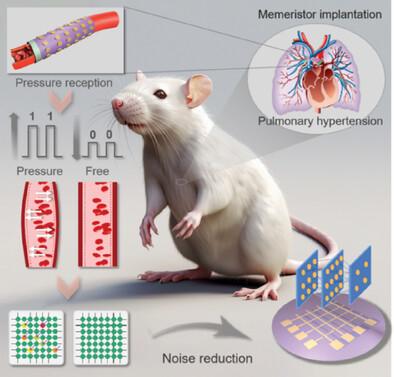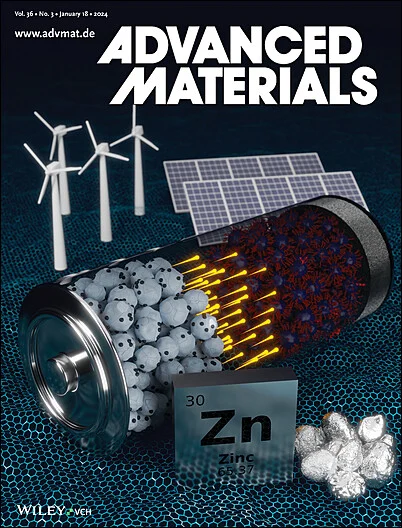A High-Stability Pressure-Sensitive Implantable Memristor for Pulmonary Hypertension Monitoring
IF 27.4
1区 材料科学
Q1 CHEMISTRY, MULTIDISCIPLINARY
引用次数: 0
Abstract
Pulmonary hypertension (PH) significantly affects the quality of life and lifespan of humans and has promoted the development of flexible implantable electronic devices for PH diagnosis and prevention. Traditional implantable devices based on the von Neumann architecture face insurmountable challenges in processing large amounts of biological data due to computational bottlenecks. Memristors, with integrated in-memory sensing and computing capabilities, can effectively eliminate computational bottlenecks and become one of the most promising products in implantable devices for health monitoring. Here, a memristor with the Ag/MnO2/BaTiO3/FTO structure is implemented and implanted into Sprague‒Dawley (SD) rats. With polydimethylsiloxane (PDMS) packaging, the device can be continuously worked in vivo for up to four weeks, demonstrating excellent stability and biocompatibility. Furthermore, a memristive sensor array is designed for pulmonary artery blood pressure monitoring based on the pressure-responsive characteristics of the as-prepared memristive device. The front-end memristive sensor array can collect and feedback pressure signal, while noise reduction is achieved through memristive logic circuits, and ultimately the memristor neural network processes and classifies the information. Therefore, this work demonstrates the potential of implantable memristors for pulmonary artery pressure monitoring and provides new inspiration for the design of efficient, real-time, and reliable implantable pressure monitoring devices in medical health monitoring.

用于肺动脉高压监测的高稳定性压力敏感型植入式可记忆晶体管
肺动脉高压(PH)严重影响人类的生活质量和寿命,促进了用于肺动脉高压诊断和预防的灵活植入式电子设备的发展。由于计算瓶颈,基于冯-诺依曼架构的传统植入式设备在处理大量生物数据时面临着难以克服的挑战。集成了内存传感和计算功能的忆阻器可以有效消除计算瓶颈,成为最有前景的健康监测植入式设备产品之一。在这里,我们实现了一种具有Ag/MnO2/BaTiO3/FTO结构的忆阻器,并将其植入Sprague-Dawley(SD)大鼠体内。通过聚二甲基硅氧烷(PDMS)封装,该装置可在体内连续工作长达四周,显示出卓越的稳定性和生物相容性。此外,根据制备的忆阻器的压力响应特性,还设计了用于肺动脉血压监测的忆阻器传感器阵列。前端忆阻器传感器阵列可以收集和反馈压力信号,同时通过忆阻器逻辑电路实现降噪,最终由忆阻器神经网络对信息进行处理和分类。因此,这项工作证明了植入式忆阻器在肺动脉压力监测方面的潜力,并为医疗健康监测领域设计高效、实时、可靠的植入式压力监测设备提供了新的灵感。
本文章由计算机程序翻译,如有差异,请以英文原文为准。
求助全文
约1分钟内获得全文
求助全文
来源期刊

Advanced Materials
工程技术-材料科学:综合
CiteScore
43.00
自引率
4.10%
发文量
2182
审稿时长
2 months
期刊介绍:
Advanced Materials, one of the world's most prestigious journals and the foundation of the Advanced portfolio, is the home of choice for best-in-class materials science for more than 30 years. Following this fast-growing and interdisciplinary field, we are considering and publishing the most important discoveries on any and all materials from materials scientists, chemists, physicists, engineers as well as health and life scientists and bringing you the latest results and trends in modern materials-related research every week.
 求助内容:
求助内容: 应助结果提醒方式:
应助结果提醒方式:


